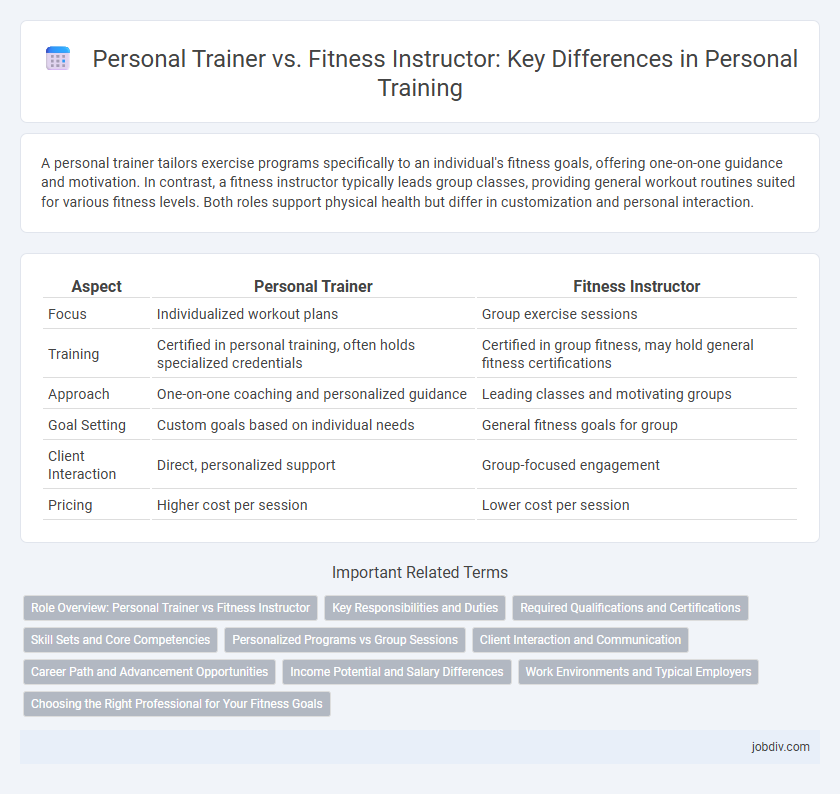A personal trainer tailors exercise programs specifically to an individual's fitness goals, offering one-on-one guidance and motivation. In contrast, a fitness instructor typically leads group classes, providing general workout routines suited for various fitness levels. Both roles support physical health but differ in customization and personal interaction.
Table of Comparison
| Aspect | Personal Trainer | Fitness Instructor |
|---|---|---|
| Focus | Individualized workout plans | Group exercise sessions |
| Training | Certified in personal training, often holds specialized credentials | Certified in group fitness, may hold general fitness certifications |
| Approach | One-on-one coaching and personalized guidance | Leading classes and motivating groups |
| Goal Setting | Custom goals based on individual needs | General fitness goals for group |
| Client Interaction | Direct, personalized support | Group-focused engagement |
| Pricing | Higher cost per session | Lower cost per session |
Role Overview: Personal Trainer vs Fitness Instructor
Personal trainers create customized workout plans that focus on individual goals such as weight loss, muscle gain, or rehabilitation, providing one-on-one coaching and motivation. Fitness instructors typically lead group exercise classes, offering general guidance and ensuring safety while promoting overall fitness and well-being. Both roles require certification but differ in scope, with personal trainers emphasizing tailored programs and fitness instructors focusing on group dynamics and class engagement.
Key Responsibilities and Duties
A Personal Trainer designs customized workout plans and provides one-on-one coaching to help clients achieve specific fitness goals, focusing on exercise technique, motivation, and progress tracking. Fitness Instructors lead group exercise classes, demonstrate proper form, and ensure participant safety while maintaining an engaging and energetic environment. Both roles emphasize client health and fitness education but differ primarily in individualized attention versus group facilitation.
Required Qualifications and Certifications
Personal trainers typically require certifications such as NASM, ACE, or ACSM, which emphasize individualized fitness assessments and tailored workout plans. Fitness instructors often hold group fitness certifications like AFAA or Les Mills, focusing on leading exercise classes and motivating participants. Both roles demand CPR and AED certification, but personal trainers usually need more in-depth knowledge of anatomy and exercise science.
Skill Sets and Core Competencies
Personal trainers possess specialized skills in individualized fitness assessment, customized program design, and one-on-one client motivation, emphasizing tailored goal achievement and injury prevention. Fitness instructors focus on group exercise leadership, choreography, and creating engaging class environments to enhance overall participant performance and adherence. Core competencies for personal trainers include in-depth anatomy knowledge and behavioral coaching, while fitness instructors excel in communication, rhythm, and group dynamic management.
Personalized Programs vs Group Sessions
Personal trainers design personalized programs tailored to individual fitness goals, health conditions, and preferences, ensuring maximum effectiveness and motivation. Fitness instructors lead group sessions that focus on general fitness, accommodating various skill levels but providing less customization. Personalized training optimizes progress through one-on-one attention, while group sessions promote social interaction and consistent energy.
Client Interaction and Communication
Personal trainers provide tailored one-on-one coaching, focusing on individual client goals, progress, and feedback through personalized communication methods such as in-depth consultations and regular progress assessments. Fitness instructors typically lead group classes, managing communication to motivate and engage multiple participants simultaneously, often using general instructions and visual cues. Effective client interaction for personal trainers emphasizes personalized encouragement and real-time adjustments, while fitness instructors rely on clear, energetic communication to maintain group cohesion and enthusiasm.
Career Path and Advancement Opportunities
Personal trainers typically have opportunities to advance by specializing in areas such as strength conditioning, nutrition, or rehabilitation, often requiring certifications like NASM or ACE. Fitness instructors may progress to managing group classes or becoming wellness coaches, with career growth often tied to gaining expertise in various fitness modalities. Both career paths offer potential for entrepreneurship, but personal trainers generally have a more defined trajectory toward individualized client services and higher earning potential.
Income Potential and Salary Differences
Personal trainers typically earn higher income potential compared to fitness instructors due to their specialized one-on-one training services which command premium rates, often ranging from $40,000 to $70,000 annually or more depending on location and clientele. Fitness instructors usually receive a lower base salary, commonly between $25,000 and $45,000 per year, as they lead group classes with less individualized attention. Certification level, experience, and market demand heavily influence salary differences in both professions, with independent personal trainers often generating the highest earnings through private sessions and client retention.
Work Environments and Typical Employers
Personal trainers often work in gyms, fitness centers, or private studios, tailoring individualized workout plans for clients, while fitness instructors commonly lead group classes in community centers, corporate wellness programs, or public recreation facilities. Personal trainers may also be self-employed, providing one-on-one sessions at clients' homes or online, whereas fitness instructors typically operate within structured schedules set by health clubs or educational institutions. Employment environments for both roles prioritize health promotion but differ in terms of personalized attention versus group engagement.
Choosing the Right Professional for Your Fitness Goals
Selecting the right fitness professional is crucial for achieving specific health goals; personal trainers offer customized workout plans and one-on-one coaching tailored to individual needs. Fitness instructors typically lead group classes and provide general guidance suitable for a broad audience, making them ideal for those seeking motivation and social interaction. Understanding your fitness objectives helps determine whether personalized attention or group motivation aligns better with your routine and progress.
Personal Trainer vs Fitness Instructor Infographic

 jobdiv.com
jobdiv.com